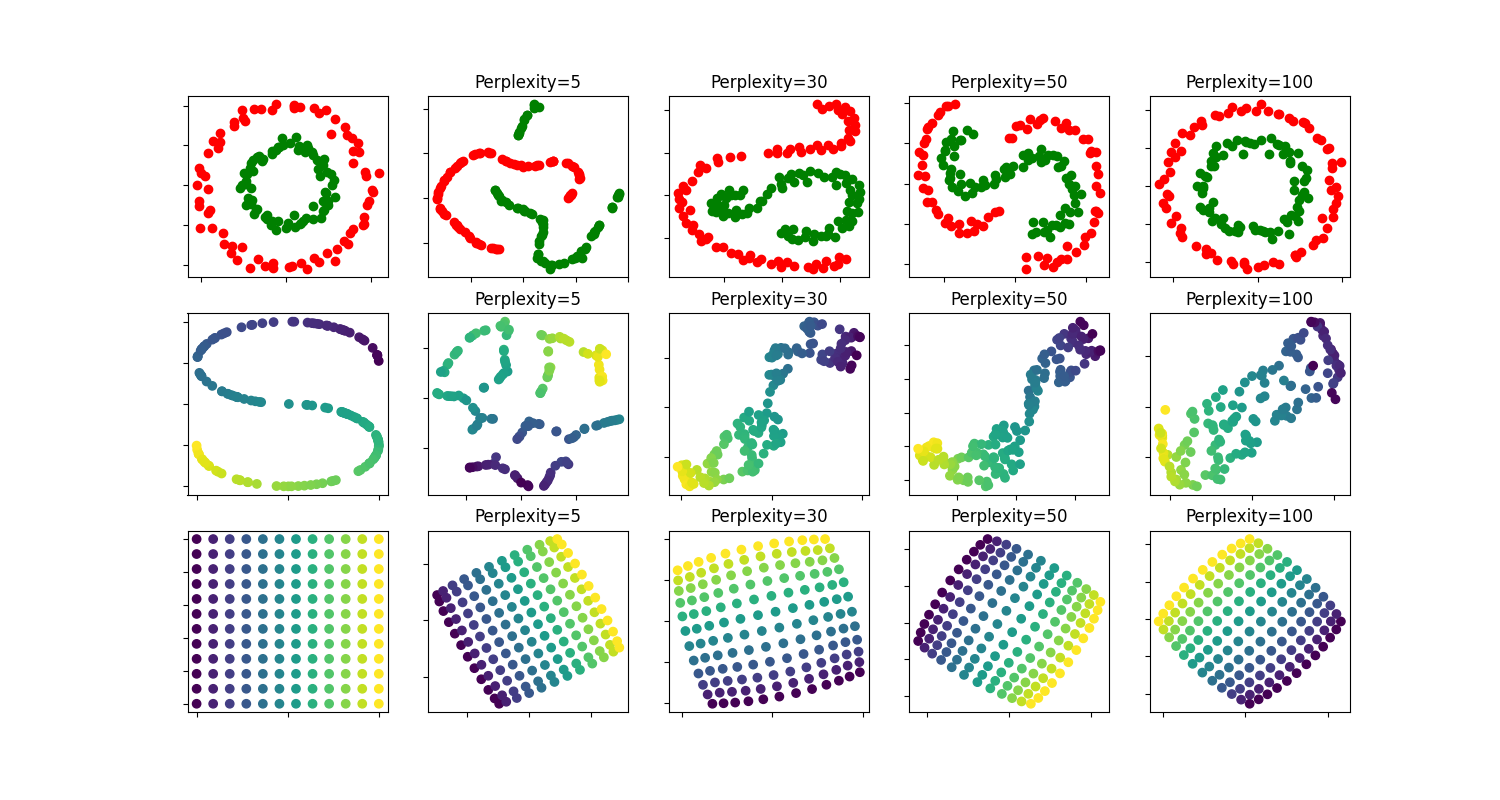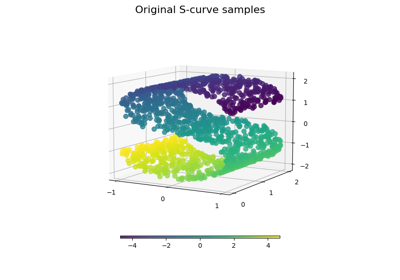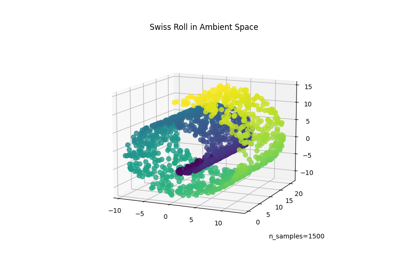Note
Go to the end to download the full example code. or to run this example in your browser via Binder
t-SNE:不同困惑度值对形状的影响#
在两个同心圆和S曲线数据集上展示了不同困惑度值的t-SNE效果。
我们观察到,随着困惑度值的增加,形状趋于更加清晰。
簇的大小、距离和形状可能会因初始化和困惑度值的不同而变化,并不总是具有意义。
如下所示,对于较高的困惑度值,t-SNE能够找到两个同心圆的有意义拓扑结构,但圆的大小和距离与原始数据略有不同。与两个圆的数据集相反,即使在较大的困惑度值下,S曲线数据集上的形状在视觉上也会偏离S曲线的拓扑结构。
有关更多详细信息,”如何有效使用t-SNE” https://distill.pub/2016/misread-tsne/ 提供了对各种参数影响的良好讨论,以及用于探索这些影响的交互式图表。

circles, perplexity=5 in 0.21 sec
circles, perplexity=30 in 0.37 sec
circles, perplexity=50 in 0.42 sec
circles, perplexity=100 in 0.42 sec
S-curve, perplexity=5 in 0.23 sec
S-curve, perplexity=30 in 0.34 sec
S-curve, perplexity=50 in 0.4 sec
S-curve, perplexity=100 in 0.4 sec
uniform grid, perplexity=5 in 0.26 sec
uniform grid, perplexity=30 in 0.41 sec
uniform grid, perplexity=50 in 0.45 sec
uniform grid, perplexity=100 in 0.45 sec
# 作者:scikit-learn 开发者
# SPDX 许可证标识符:BSD-3-Clause
from time import time
import matplotlib.pyplot as plt
import numpy as np
from matplotlib.ticker import NullFormatter
from sklearn import datasets, manifold
n_samples = 150
n_components = 2
(fig, subplots) = plt.subplots(3, 5, figsize=(15, 8))
perplexities = [5, 30, 50, 100]
X, y = datasets.make_circles(
n_samples=n_samples, factor=0.5, noise=0.05, random_state=0
)
red = y == 0
green = y == 1
ax = subplots[0][0]
ax.scatter(X[red, 0], X[red, 1], c="r")
ax.scatter(X[green, 0], X[green, 1], c="g")
ax.xaxis.set_major_formatter(NullFormatter())
ax.yaxis.set_major_formatter(NullFormatter())
plt.axis("tight")
for i, perplexity in enumerate(perplexities):
ax = subplots[0][i + 1]
t0 = time()
tsne = manifold.TSNE(
n_components=n_components,
init="random",
random_state=0,
perplexity=perplexity,
max_iter=300,
)
Y = tsne.fit_transform(X)
t1 = time()
print("circles, perplexity=%d in %.2g sec" % (perplexity, t1 - t0))
ax.set_title("Perplexity=%d" % perplexity)
ax.scatter(Y[red, 0], Y[red, 1], c="r")
ax.scatter(Y[green, 0], Y[green, 1], c="g")
ax.xaxis.set_major_formatter(NullFormatter())
ax.yaxis.set_major_formatter(NullFormatter())
ax.axis("tight")
# 另一个使用S曲线的例子
X, color = datasets.make_s_curve(n_samples, random_state=0)
ax = subplots[1][0]
ax.scatter(X[:, 0], X[:, 2], c=color)
ax.xaxis.set_major_formatter(NullFormatter())
ax.yaxis.set_major_formatter(NullFormatter())
for i, perplexity in enumerate(perplexities):
ax = subplots[1][i + 1]
t0 = time()
tsne = manifold.TSNE(
n_components=n_components,
init="random",
random_state=0,
perplexity=perplexity,
learning_rate="auto",
max_iter=300,
)
Y = tsne.fit_transform(X)
t1 = time()
print("S-curve, perplexity=%d in %.2g sec" % (perplexity, t1 - t0))
ax.set_title("Perplexity=%d" % perplexity)
ax.scatter(Y[:, 0], Y[:, 1], c=color)
ax.xaxis.set_major_formatter(NullFormatter())
ax.yaxis.set_major_formatter(NullFormatter())
ax.axis("tight")
# 另一个使用二维均匀网格的例子
x = np.linspace(0, 1, int(np.sqrt(n_samples)))
xx, yy = np.meshgrid(x, x)
X = np.hstack(
[
xx.ravel().reshape(-1, 1),
yy.ravel().reshape(-1, 1),
]
)
color = xx.ravel()
ax = subplots[2][0]
ax.scatter(X[:, 0], X[:, 1], c=color)
ax.xaxis.set_major_formatter(NullFormatter())
ax.yaxis.set_major_formatter(NullFormatter())
for i, perplexity in enumerate(perplexities):
ax = subplots[2][i + 1]
t0 = time()
tsne = manifold.TSNE(
n_components=n_components,
init="random",
random_state=0,
perplexity=perplexity,
max_iter=400,
)
Y = tsne.fit_transform(X)
t1 = time()
print("uniform grid, perplexity=%d in %.2g sec" % (perplexity, t1 - t0))
ax.set_title("Perplexity=%d" % perplexity)
ax.scatter(Y[:, 0], Y[:, 1], c=color)
ax.xaxis.set_major_formatter(NullFormatter())
ax.yaxis.set_major_formatter(NullFormatter())
ax.axis("tight")
plt.show()
Total running time of the script: (0 minutes 4.647 seconds)
Related examples





